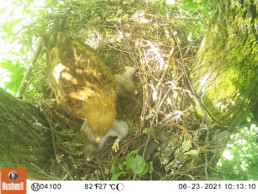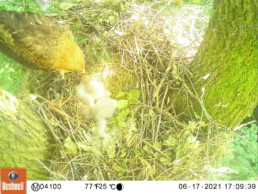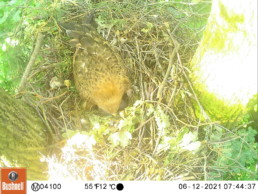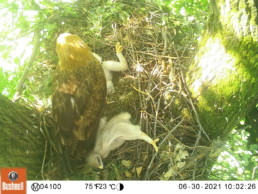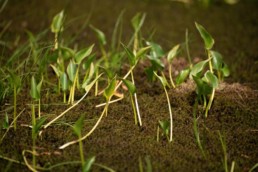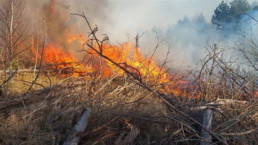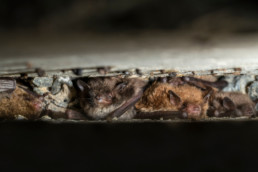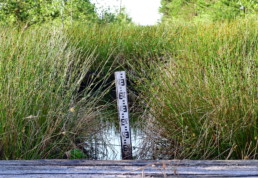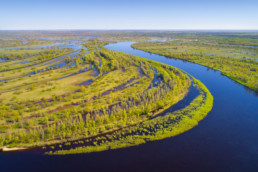Through a camera trap: the secret life of rare eagles at arm’s reach
Sitting for hours in the bushes and marshes, peering through a telescope or a binocular - a decade or two ago, this was the only way to make scanty observations of nesting Greater Spotted Eagles. These birds are elusive and difficult to observe, especially during the breeding season when they are extremely sensitive to human disturbance. Nowadays, however, camera traps set up next to a nest can give us a valuable glimpse into the family life of these rare eagles and reveal many important and curious facts about them. We invite you to find out how we observed a nesting pair of Greater Spotted Eagles through the lens of a camera trap.
In 2021, the female Greater Spotted Eagle of unusual light colour returned to her nest on the 2nd of April. This individual is very remarkable: Greater Spotted Eagles with pale morph are very rare in the European part of their range, and this very bird became the first Greater Spotted Eagle with such a phenotype observed in the Belarusian Polesia. Will her chicks inherit the pale morph? We can’t predict that.
The male Greater Spotted Eagle – with rings on his legs and a GPS transmitter on his back – appeared two days later, on the 4th of April.
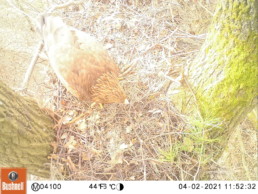
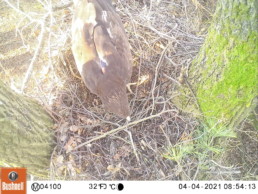
Greater Spotted Eagles often build their nest on a branch fork high above the ground, so that their home is hidden behind dense foliage. Typically, the same nest is used by the same pair of birds for several years in a row. Having returned home, the birds immediately started working hard improving the old nest. They carried new branches to their nest for more than 2 weeks. Compare its appearance before and after the renovation!
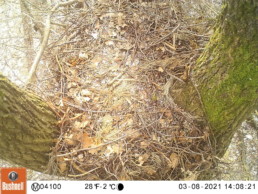
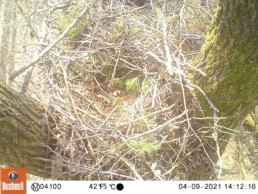
In late April, the female Greater Spotted Eagle spends a lot of time in the nest: she is about to lay eggs. A Greater Spotted Eagle usually lays from 1 to 3 eggs, with a break in time. And here it is! We observe the first egg on the 30th of April. On the 4th of May we see two eggs in the nest already.
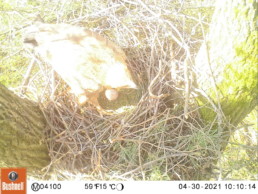
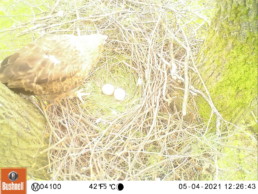
Now, the incubation of the eggs begins. It lasts from 40 to 44 days on average. Previously, researchers supposed that only the female stays in the nest throughout the entire incubation period. But the camera traps pictures show that the birds take turns incubating the eggs. The female spends more time in the nest. However, the male often gives her time to hunt and stretch her wings. It is quite cold in early May, only 5-10 °C. The female spreads her feathers to keep herself and the eggs warm.
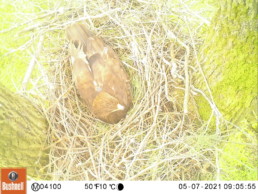
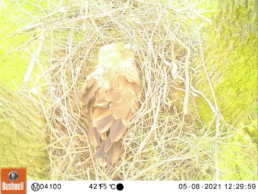
The male eagle feeds the female while she incubates the eggs. Information on the composition of the Greater Spotted Eagle’s diet is very important for the study and conservation of this species. And camera traps give us a chance to observe what the birds eat! This time, it’s a vole. Small rodents are common prey of the Greater Spotted Eagles.
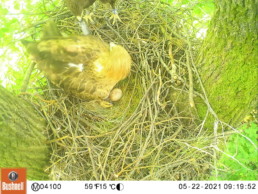
At the beginning of June, our Greater Spotted Eagles look forward to the most exciting event of the nesting season: their chicks are about to hatch. The female’s powerful paws with sharp claws allow her to tear apart her prey easily. But look how delicately she holds the egg!
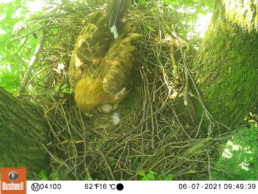
Finally, the long-awaited moment comes: the first chick hatches on the 8th of June after 5 weeks of incubation! The parents celebrate with big catch: this time, it’s a hare. While the female is busy with the prey, we can see the first hatched chick clearly – it is one day old!
On the 12th of June, we see the second chick free of its shell. But will it survive? Greater Spotted Eagles have a strong tendency to cainism: a second-hatched chick often dies within the first two weeks, and its death is directly or indirectly caused by the elder.
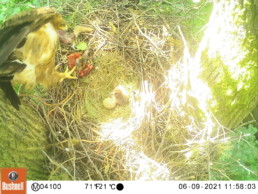
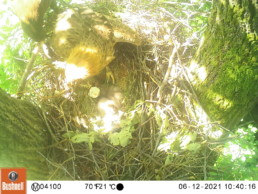
At about two weeks old, the chicks of the Greater Spotted Eagles are quite active, stretching their wings and crawling. The adult birds have to keep an eye on them all the time so that they don’t fall out of the nest.
Meanwhile, the male has to spend a lot of time hunting to provide food for himself, the female and their chicks. The camera trap captured rodents and a mallard chick among their prey. The female feeds the chicks in turns tearing the prey into small pieces. The older chick is bigger, stronger and more assertive. But the adults pay equal attention to the second-hatched one, too. Obviously, it has a good chance to survive!
The older chick is nearly 3 weeks old, with the first feathers visible among the down covering its body. Remarkably, the parents started leaving the chicks alone in the nest for short periods! The fast-growing chicks need a lot of food, so the adults have to spend a lot of time hunting. This time the male caught a weasel.
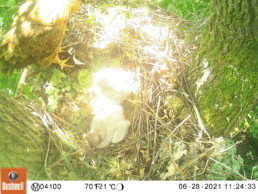
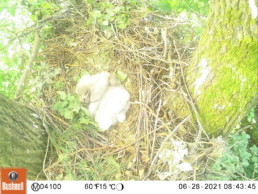
As the camera trap photos prove, the diet of the Greater Spotted Eagle is quite varied. In the photo below, the female seems to reproachfully look at the chicks as they turned away from the fish. But the next day we see a chick trying to eat a vole on its own while the adults are away!
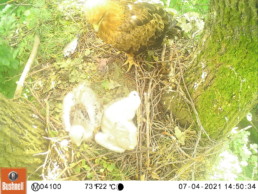
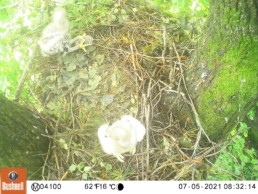
When raising chicks, adult Greater Spotted Eagles permanently renew their nest with fresh branches of oak, alder and birch. In this way, the birds cover the remains of prey and droppings, keeping the nest clean.
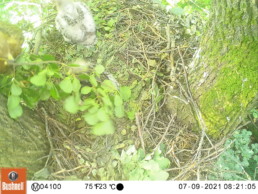
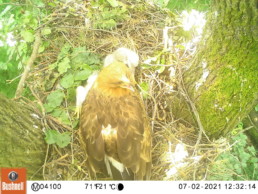
It’s early July, and the first-hatched chick is one month old. The second one is just a few days younger, but the difference is still noticeable – they are growing so fast! Both chicks continue receiving equal care and nutrition, and it’s very likely that both will survive.
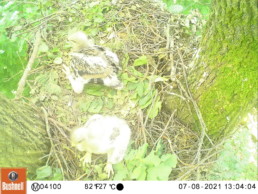
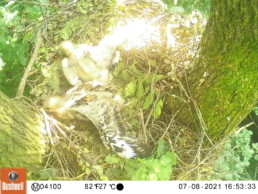
By mid-July, the Greater Spotted Eagles chicks have grown quite big and strong and no longer need the constant presence of their parents. Ornithologists choose this time to replace the batteries and SD cards of the camera trap on the nest and ring the chicks. Look, one of them has a new ring on its leg! The chicks often flap their wings in training for their first flight. But the female still cares for them tirelessly. The camera trap caught her shielding the chicks from the sun with her wings.
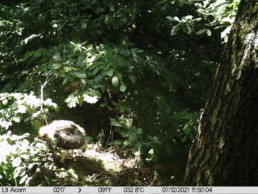
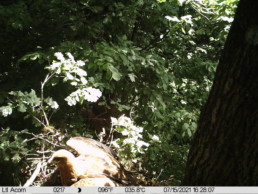
Most often, Greater Spotted Eagles hunt small mammals. However, the most part of the biomass consumed by these predators consists of birds. Sometimes, even large birds: the bones identified on these camera traps images belonged to a heron!
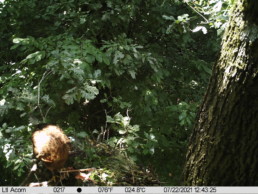
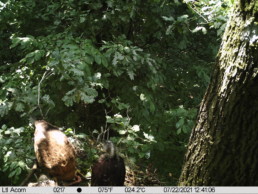
At the beginning of the nesting season, we guessed whether the new chicks of the pale female would be of the rare pale or typical dark colour. In the second half of the summer we can clearly see that they have inherited the morph of their father and have grown up to the typical dark colour of the Greater Spotted Eagle. However, there are known cases when chicks of two different phenotypes have been observed in the same brood!
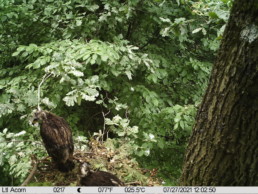
By mid-August, the breeding story is over: the fledglings left the nest! They were last seen by our ornithologists in early September, when the young birds are usually quite independent. This is a remarkable story: both chicks survived and grew up! We hope that they are still well and that one day the rings will tell us more about them thanks.
Follow us on our Twitter account. There you will find more information about the wildlife of Polesia and more pictures from our camera trap surveys!
Safe and intact: protecting rare and typical habitats in Polesia
19. September 2025
0 Comments7 Minutes
The project “Polesia – Wilderness Without Borders” is part of the Endangered Landscapes & Seascapes Programme and is funded by Arcadia. The project is coordinated by Frankfurt Zoological Society (FZS).


